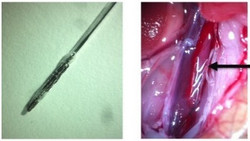Prevention of late stent thrombosis
State-of-the-art stents release drugs into the nearby blood vessel to prevent restenosis (re-narrowing of the vessel). Unfortunately, these drug-releasing stents can increase the occurrence of blood clot formation, known in this case as stent thrombosis. The EU funded the PRESTIGE(opens in new window) (Prevention of late stent thrombosis by an interdisciplinary global European effort) project to address this problem through a multidisciplinary approach. The EU-wide consortium improved diagnostic tools and investigated technical measures to prevent or reduce the occurrence of stent thrombosis. Researchers compiled the largest databank of stent thrombosis cases with multimodal assessment worldwide. Early insights revealed an unexpected high prevalence of accelerated in-stent atherosclerosis in the aetiology of these events. Further exploitation of the data for risk factor algorithm construction is planned. An in-depth mouse stent model was used to investigate the mechanisms of thrombosis and different coatings that may prevent it, in particular the most common material used: cobalt-chrome Findings indicate that material of the stent may activate the coagulation cascade and that additional anticoagulant treatment strategies should be investigated. The most successful approaches involved plasma treatment of stent surfaces, attachment of peptidomimetics to attract endothelial cells, chitosan polymer coatings, and dextran-based co-polymers to favourably modulate platelet-stent interactions and coagulation pathways. In a further step, stented arteries derived from atherosclerotic rabbit models and human ex vivo specimens were used for development of sensitive algorithms for optical imaging for the detection of immature tissue-type and neoatherosclerosis, often a precursor of late stent thrombosis. Another key output was a novel near-infrared fluorescence imaging catheter specifically designed for animal studies Foam cells accumulation around stent struts was identified as an important disease hallmark. In the animal model, researchers were able to detect different endothelial cell quantities within the vessel, with a weaker fluorescent signal in areas of denuded aortas. PRESTIGE research deliverables will not only contribute to a reduction in the clinical burden of stent thrombosis. Improved treatment and diagnosis for coronary artery disease with the new imaging techniques as well as more effective stent treatment for cerebrovascular and peripheral artery disease are just two of the benefactors.







